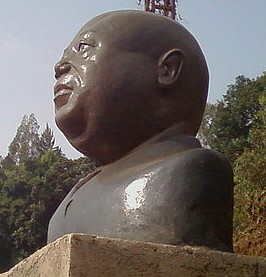Mobutu & The Congo Wars (1996-1998)

A statue of rebel leader Kabila. (Creative Commons photo. Attribution to author and info can be found here)
The Congo had been pretty quiet since the Congo Crisis, but some of the issues left unresolved, along with ethnic issues around them, caused a resurgence in issues. President Mobutu declared a state of emergency, shutdown the government, and banned all political parties because he claimed that politicians had ruined the country. All citizens were forced to join his party, the Popular Movement of the Revolution (MPR). This effectively made him the dictator of the country, but tried to calm the people by calling himself a moderate who was neither capitalist or communist. He then started to rig elections to give himself even more power, making himself president for life. Anyone who disagreed with him would be executed, dealing with horrible torture or dismemberment in doing so. At the same time he tried to create a pro-African campaign to help make him more popular with the people and even pushed people to ditch their European sounding names for traditional African ones.
He became a pariah with the majority of the international community due to his actions during this time period. US President Ronald Reagan bucked the trend a bit by claiming he was a “voice of good sense and goodwill’ and gave him money because of his pro-US Cold War stance, but after the Cold War ended we removed support. He ended the ban on political parties and started elections in the hopes that this could rehabilitate his image, but he ordered all ethnic Tutsis to leave his country or die right before doing this.
These were largely refugees from the Rwandan Genocide, so this caused a number of countries to attack him. He was in no condition to fight this at this time in his life, so he went into exile instead (dying soon after from cancer).
When Mobutu was removed from power this created a political crisis that became known as the 1st Congo War (1996-1997). A rebel leader named Laurent-Désiré Kabila declared himself president and moved the country towards a democracy. He united the Tutsis to fight the government with the help of neighboring Rwanda and Uganda. In an interesting twist, he turned on the Tutsis when he became president, which led the two other countries to fight him also. Mobutu’s old allies on the other hand fought to keep things the same, forming the Alliance of Democratic Forces for the Liberation of Zaire (AFDL). The fighting would cost the lives of an estimated 60,000 civilians, which the AFDL denies. President Kabila started using 10,000 child soldiers to turn the war in his favor, which actually did work for him and turned the tide of the war.
President Kabila changed the name of the country to the Democratic Republic of the Congo as the fighting started to calm. He did his best to find a middle ground between capitalism and communism so that he didn’t take a side and stayed as popular as can be. The international press called him a “new breed” of African leader and said some positive things about him. Within a few years as leader it was clear he was yet another form of authoritarian leader in Africa, although you wouldn’t have known that in his own country because he plastered propaganda all over the country to make himself look good.
As more people in the international community turned against President Kabila, the ethnic tensions between Tutsi and Hutu flared back up again. Hutu refugees in Congo started crossing the border into Tutsi led Rwanda and attacking. There were a good deal of people that claimed Kabila was instigating these attacks, which was possible, so Rwanda declared war on the Congo. This turned into the largest war in modern African history with 8 countries involved in the fighting. Kabila stoked resentment among the Hutu militias to change the opinions of him, but this turned into a handful of street justice public hangings on the streets of Kinshasa. Eventually the countries met and agreed to peace without any real changes being forced on the country. President Kabila was shot and killed by one of his own staff members named Eddy Kapend in 2001. Around 100 people were thrown in jail for this assassination, but most of the rest of the world applauded his death.

The location of the Congo. (Creative Commons photo. Attribution to author and info can be found here)
